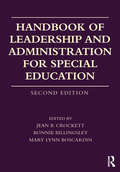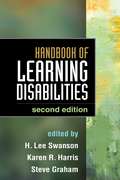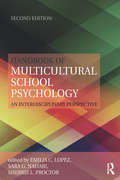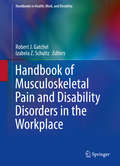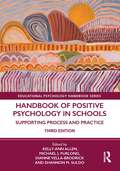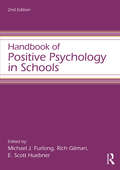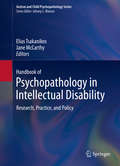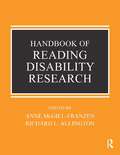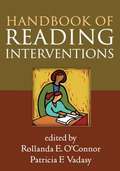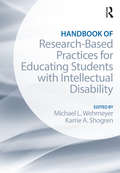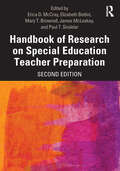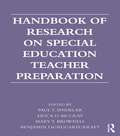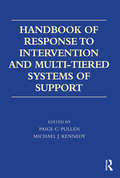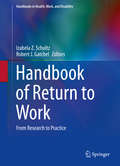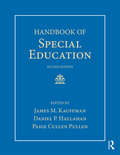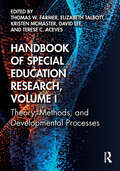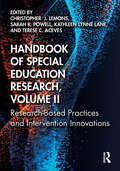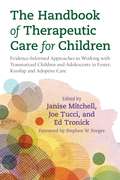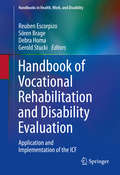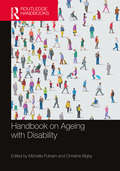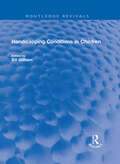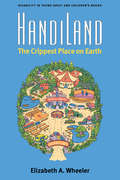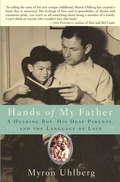- Table View
- List View
Handbook of Leadership and Administration for Special Education
by Jean B. Crockett Bonnie Billingsley Mary Lynn BoscardinThe Handbook of Leadership and Administration for Special Education brings together research informing practice in leading special education from preschool through transition into postsecondary settings. The second edition of this comprehensive handbook has been fully updated to provide coverage of disability policy, historical roots, policy and legal perspectives, as well as effective, collaborative, and instructional leadership practices that support the administration of special education. It can be used as a reference volume for scholars, administrators, practitioners, and policy makers, as well as a textbook for graduate courses related to the administration of special education.
Handbook of Learning Disabilities, Second Edition
by H. Lee Swanson Steve Graham Karen R. HarrisWidely regarded as the standard reference in the field, this comprehensive handbook presents state-of-the-art knowledge about the nature and classification of learning disabilities (LD), their causes, and how individuals with these difficulties can be identified and helped to succeed. Best practices are described for supporting student performance in language arts, math, and other content areas. Contributors also identify general principles of effective instruction and review issues in service delivery within response-to-intervention (RTI) frameworks. The book critically examines the concepts and methods that guide LD research and highlights important directions for future investigation. New to This Edition: *Incorporates key advances in identifying and remediating LD, with particular attention to the role of RTI. *Chapters on social cognitive, behavioral genetic, and neurobiological aspects. *Chapters on adolescents and adults with LD. *Chapters on spelling instruction, history instruction, and classroom technology applications. *Chapter synthesizing 21st-century advances in LD research methods, plus chapters on advanced statistical models, single-case designs, and meta-analysis.
Handbook of Multicultural School Psychology: An Interdisciplinary Perspective (Consultation, Supervision, and Professional Learning in School Psychology Series)
by Emilia C. Lopez Sara G. Nahari Sherrie L. ProctorThe second edition of the Handbook of Multicultural School Psychology continues the mission of its predecessor, offering a comprehensive, interdisciplinary view of the field of multicultural school psychology and addressing the needs of children and families from diverse cultural backgrounds. The revised organizational structure includes the following: History and Professional Issues; Consultation and Collaboration; Interventions Focused on Academic and Mental Health Issues; Data-based Decision Making; Systems-based Issues; Training and Research; and Future Perspectives. Nineteen of the volume's twenty-three chapters are completely new to this edition, while the rest have been effectively revised and updated. Comprehensive—In seven sections, this book covers theoretical, research, and practical concerns in a wide range of areas that include multicultural and bilingual issues, second language acquisition, acculturation, parent collaboration, research, and systemic issues. Chapter Structure—Chapter authors follow a uniform structure that includes theoretical and research issues and implications for practice. Recent practice and training guidelines including Blueprint for Training and Practice III (2006), NASP Model for Comprehensive and Integrated School Psychological Services (2010), and APA Multicultural Guidelines (2003) are covered. Interdisciplinary Perspective—Contributing authors are from a wide range of related fields that include school psychology, special education, general education, early childhood education, educational psychology, clinical psychology, counseling, and mental health, thus exposing readers to theory and research from various approaches. Changes—New to this edition is a section focusing on systemic issues such as overrepresentation of culturally and linguistically diverse (CLD) students in special education, prejudice, response to intervention (RTI) for CLD students and English Language Learners (ELL), and end-of-chapter discussion questions. This book is ideal for graduate courses and seminars on multicultural school psychology. It is also a useful reference for researchers and practicing school psychologists and the libraries that serve them.
Handbook of Musculoskeletal Pain and Disability Disorders in the Workplace
by Robert J. Gatchel Izabela Z. SchultzThis book addresses the complexity of preventing, diagnosing, and treating musculoskeletal pain and disability disorders in the workplace. Divided evenly between common occupational pain disorders, conceptual and methodological issues, and evidence-based intervention methods, this comprehensive reference presents current findings on prevalence, causation, and physical and psychological aspects common to these disorders. Attention is given to working-world concerns, including insurance and compensation issues and AMA guidelines for disability evaluations. Also, specialized chapters offer lenses for understanding and administering the best approaches for treating specific pain disorders, and explore what workplaces can do to accommodate affected employees and prevent injuries from occurring in the first place.
Handbook of Positive Psychology in Schools: Supporting Process and Practice (Educational Psychology Handbook)
by Kelly-Ann AllenThe Handbook of Positive Psychology in Schools offers the most current and comprehensive insights into how positive psychology principles provide a framework for young people to become active agents in their own learning. The third edition of this groundbreaking volume assembles the latest global research identifying fundamental assets—hope, optimism, gratitude, self-efficacy, emotional regulation, among others—that support students’ learning and well-being. Chapters examining social-ecological perspectives on classroom quality and school climate provide best practice guidance on schoolwide policies and practices. These 35 new chapters explore positive psychology’s ongoing influence and advances on prevention, intervention, and assessment practices in schools.
Handbook of Positive Psychology in Schools: Supporting Process And Practice (Educational Psychology Handbook)
by Michael J. Furlong Rich Gilman E. Scott HuebnerUnderstanding the factors that encourage young people to become active agents in their own learning is critical. Positive psychology is one lens that can be used to investigate the factors that facilitate a student’s sense of agency and active school engagement. In the second edition of this groundbreaking handbook, the editors draw together the latest work on the field, identifying major issues and providing a wealth of descriptive knowledge from renowned contributors. Major topics include: the ways that positive emotions, traits, and institutions promote school achievement and healthy social and emotional development; how specific positive-psychological constructs relate to students and schools and support the delivery of school-based services; and the application of positive psychology to educational policy making. With thirteen new chapters, this edition provides a long-needed centerpiece around which the field can continue to grow, incorporating a new focus on international applications of the field.
Handbook of Psychopathology in Intellectual Disability
by Elias Tsakanikos Jane MccarthyThe complex intersecting of genetic, biological, and environmental factors can make intellectual impairments difficult for clinicians to assess and treat. When such comorbid conditions as substance abuse or bipolar disorder are part of the equation, so are increased risks for clinical uncertainties and therapeutic dead-ends. The Handbook of Psychopathology in Intellectual Disability reflects the diversity of its subject in prevalence and presentation, testing methods and treatment options. Besides focusing on specific pathologies as they affect the course of intellectual disability (ID), its coverage spans the field from in-depth analyses of psychosocial aspects of ID to promising new findings in genetics and the ongoing challenge of providing personalized care tailored to individual client needs. Expert contributors bridge gaps between the evidence base and best practices and improved policy for maximum utility. In addition, chapters are written to benefit the widest variety of professionals treating clients with ID across disciplines. Key areas featured in the Handbook include: General issues and assessment methods. Core etiological approaches, including neuroimaging. Comorbid psychopathology, including mood, anxiety, and personality disorders. Common clinical conditions, such as ADHD, autism, and behavior problems. Medical and psychological interventions as well as community and inpatient services. Future directions in research and evidence-based practices. The Handbook of Psychopathology in Intellectual Disability is an essential reference for researchers, professors, and graduate students as well as clinicians and other scientist-practitioners in clinical psychology, psychiatry, social work, rehabilitation medicine, public health, and neuropsychology.
Handbook of Reading Disability Research
by John Elkins William Rupley Richard L. Allington S. Jay Samuels Victor L. Willson Anne McGill-Franzen George Hruby Peter Johnston Susan Hupp Victoria Risko Patricia AndersBringing together a wide range of research on reading disabilities, this comprehensive Handbook extends current discussion and thinking beyond a narrowly defined psychometric perspective. Emphasizing that learning to read proficiently is a long-term developmental process involving many interventions of various kinds, all keyed to individual developmental needs, it addresses traditional questions (What is the nature or causes of reading disabilities? How are reading disabilities assessed? How should reading disabilities be remediated? To what extent is remediation possible?) but from multiple or alternative perspectives. Taking incursions into the broader research literature represented by linguistic and anthropological paradigms, as well as psychological and educational research, the volume is on the front line in exploring the relation of reading disability to learning and language, to poverty and prejudice, and to instruction and schooling. The editors and authors are distinguished scholars with extensive research experience and publication records and numerous honors and awards from professional organizations representing the range of disciplines in the field of reading disabilities. Throughout, their contributions are contextualized within the framework of educators struggling to develop concrete instructional practices that meet the learning needs of the lowest achieving readers.
Handbook of Reading Interventions
by Patricia Vadasy Rollanda O'ConnorComprehensive, authoritative, and designed for practical utility, this handbook presents evidence-based approaches for helping struggling readers and those at risk for literacy difficulties or delays. Leading experts explain how current research on all aspects of literacy translates into innovative classroom practices. Chapters include clear descriptions of effective interventions for word recognition, spelling, fluency, vocabulary, comprehension, and writing, complete with concrete examples and teaching scripts. Coverage also encompasses preschool literacy instruction and interventions for older readers, English language learners, and students with learning disabilities, as well as peer-mediated and tutoring approaches.
Handbook of Research-Based Practices for Educating Students with Intellectual Disability
by Michael L. Wehmeyer Karrie A. ShogrenThe Handbook of Research-Based Practices for Educating Students with Intellectual Disability provides an integrated, transdisciplinary overview of research-based practices for teaching students with intellectual disability. This comprehensive volume emphasizes education across life stages, from early intervention in schools through the transition to adulthood, and highlights major educational and support needs of children and youth with intellectual disability. The implications of history, recent research, and existing information are positioned to systematically advance new practices and explore promising possibilities in the field. Driven by the collaboration of accomplished, nationally recognized professionals of varied approaches and philosophies, the book emphasizes practices that have been shown to be effective through multiple methodologies, so as to help readers select interventions based on the evidence of their effectiveness.
Handbook of Research on Special Education Teacher Preparation
by Erica D. McCray Elizabeth Bettini Mary T. Brownell James McLeskey Paul T. SindelarThe new edition of this landmark text expands our current understanding of teacher education broadly by providing an in-depth look at the most up-to-date research on special education teacher preparation. Offering a comprehensive review of research on attracting, preparing, and sustaining personnel to effectively serve students with disabilities, it is fully updated to align with current knowledge and future perspectives on special educator development, synthesizing what we can do to continue advancing as a field. The Handbook of Research on Special Education Teacher Preparation is a great resource not only to special education faculty and the doctoral students they prepare, but also to scholars outside of special education who address questions related to special education teacher supply, demand, and attrition.
Handbook of Research on Special Education Teacher Preparation
by Paul T. Sindelar Mary T. Brownell Erica D. McCray Benjamin Lignugaris KraftCompilations of research on teacher preparation often include no more than a cursory mention of the specific roles and needs of special education teachers. Although the work that special education teachers perform does indeed differ from the work of classroom teachers, teacher preparation in the two fields has much in common. The purpose of this seven-part handbook is to expand our knowledge of teacher education broadly by providing an in-depth look at the most up-to-date research on special education teacher preparation. Opening chapters ground the collection in political and economic context, while subsequent sections delve deeply into issues related to the current state of our special education workforce and offer insights into how to best prepare and sustain that workforce. Ultimately, by illuminating the particularities of special education teacher preparation, this landmark handbook addresses the state of current research in the field and sets an agenda for future scholarship.
Handbook of Response to Intervention and Multi-Tiered Systems of Support
by Paige C. Pullen Michael J. KennedyOf the many issues facing special education (and general education) today, it is difficult to imagine one more important or timely than response to intervention (RTI). Almost overnight RTI has become standard practice across the nation. Unfortunately, RTI remains ill-defined, falls far short of its evidence-based practice goal, is almost invariably misused, and often results in more harm than good. Nevertheless, as a conceptual framework RTI has great potential for ensuring that students with disabilities receive appropriate, evidence-based instruction. The mission of this handbook is to present a comprehensive and integrated discussion of response to intervention (RTI) and its relation to multi-tiered systems of support (MTSS) in both special education and general education. Although the two terms are currently used interchangeably, distinct differences exist between them. Therefore, chapters are dedicated to distinguishing the two concepts—RTI and MTSS—and describing each one’s unique role in both general and special education. In addition, the authors recommend a third term, Multi-Tiered Instruction, to differentiate the practices related to the purpose of the specific intervention.
Handbook of Return to Work
by Izabela Z. Schultz Robert J. GatchelThis comprehensive interdisciplinary synthesis focuses on the clinical and occupational intervention processes enabling workers to return to their jobs and sustain employment after injury or serious illness as well as ideas for improving the wide range of outcomes of entry and re-entry into the workplace. Information is accessible along key theoretical, research, and interventive lines, emphasizing a palette of evidence-informed approaches to return to work and stay at work planning and implementation, in the context of disability prevention. Condition-specific chapters detail best return to work and stay at work practices across diverse medical and psychological diagnoses, from musculoskeletal disorders to cancer, from TBI to PTSD. The resulting collection bridges the gap between research evidence and practice and gives readers necessary information from a range of critical perspectives. Among the featured topics: Understanding motivation to return to work: economy of gains and losses. Overcoming barriers to return to work: behavioral and cultural change. Program evaluation in return to work: an integrative framework. Working with stakeholders in return to work processes. Return to work after major limb loss. Improving work outcomes among cancer survivors. Return to work among women with fibromyalgia and chronic fatigue syndrome. The Handbook of Return to Work is an invaluable, unique and comprehensive resource for health, rehabilitation, clinical, counselling and industrial psychologists, rehabilitation specialists, occupational and physical therapists, family and primary care physicians, psychiatrists and physical medicine and rehabilitation as well as occupational medicine specialists, case and disability managers and human resource professionals. Academics and researchers across these fields will also find expert guidance and direction in these pages. It is an essential reading for all return to work and stay at work stakeholders.
Handbook of Special Education
by James M. Kauffman Daniel P. Hallahan Paige Cullen PullenThe purpose of the Handbook of Special Education is to help profile and bring greater clarity to the already sprawling and continuously expanding field of special education. To ensure consistency across the volume, chapter authors review and integrate existing research, identify strengths and weaknesses, note gaps in the literature, and discuss implications for practice and future research. The second edition has been fully updated throughout to take into account recent changes to federal laws as well as the most current academic research, and an entirely new section has been added on research methods in special education.
Handbook of Special Education Research, Volume I: Theory, Methods, and Developmental Processes
by Thomas W. Farmer Elizabeth Talbott Kristen McMaster David Lee Terese C. AcevesDivided into two volumes, Handbook of Special Education Research provides a comprehensive overview of critical issues in special education research. This first volume addresses key topics in theory, methods, and development, exploring how these three domains interconnect to build effective special education research. Each chapter features considerations for future research and implications for fostering continuous improvement and innovation. Essential reading for researchers and students of special education, this handbook brings together diverse and complementary perspectives to help move the field forward.
Handbook of Special Education Research, Volume II: Research-Based Practices and Intervention Innovations
by Christopher J. Lemons Sarah R. Powell Kathleen Lynne Lane Terese C. AcevesDivided into two volumes, the Handbook of Special Education Research provides a comprehensive overview of critical issues in special education research. Volume II addresses research-based practices, offering a deep dive into tiered systems of support and advances in interventions and assessments, as well as socially, emotionally, culturally, and linguistically relevant practices. Each chapter features considerations for future research and implications for fostering continuous improvement and innovation. Essential reading for researchers and students of special education, this handbook brings together diverse and complementary perspectives to help move the field forward.
The Handbook of Therapeutic Care for Children: Evidence-Informed Approaches to Working with Traumatized Children and Adolescents in Foster, Kinship and Adoptive Care
by Martin H. Teicher Orgilmaa Munkbaatar Allan N. Schore Kathomi Gatwiri Bruce D. Perry Glenda Kickett Shaun Chandran Elaine Farmer Meredith Kiraly Noel Macnamara Daniel Hughes Jonathan Baylin Kim Golding Cathy A MalchiodiThis innovative book brings together a wide range of therapeutic approaches, techniques and models to outline recent developments in the practice of supporting children in out-of-home care. It sheds light on the significance of schools, sports and peer relationships in the lives of traumatized children. It also draws particular attention to the vital importance of taking into account children's cultural heritage, and to the growing prevalence of relative care.Each chapter is set out by acclaimed and world-renowned contributors' specific approach, such as Dan Hughes and his work on conceptual maps and Cathy Malchiodi and her research on creative interventions, and gives practical ways to support children and carers. It also includes contributions from Bruce Perry, Allan Schore and Martin Teicher. This comprehensive volume will open new avenues for understanding how the relationship between child and carer can create opportunities for change and healing.
Handbook of Vocational Rehabilitation and Disability Evaluation
by Reuben Escorpizo Sören Brage Debra Homa Gerold StuckiThis book presents the state of the art in the application and implementation of the WHO's International Classification of Functioning, Disability and Health (ICF) in the areas of vocational rehabilitation as a primary topic and disability evaluation as a secondary topic. Application of the ICF and implementation strategies toward a holistic and comprehensive approach to work disability and vocational rehabilitation programs are presented along with clinical cases and exercises. The ICF as a topic in health and disability has been gaining momentum since its approval by the World Health Assembly in 2001, and great progress has been made since then. However, the integration if the ICF in the realm of vocational rehabilitation has been lacking despite the fact that work and employment are a major area in people's lives, particularly those who have work disability. This book will advance the professional practice of vocational rehabilitation, rehabilitation counseling, occupational medicine, and allied health science.
Handbook on Ageing with Disability
by Michelle Putnam Christine BigbyMainstream gerontological scholarship has taken little heed of people ageing with disability, and they have also been largely overlooked by both disability and ageing policies and service systems. The Handbook on Ageing with Disability is the first to pull together knowledge about the experience of ageing with disability. It provides a broad look at scholarship in this developing field and across different groups of people with disability in order to form a better understanding of commonalities across groups and identify unique facets of ageing within specific groups. Drawing from academic, personal, and clinical perspectives, the chapters address topics stemming from how the ageing with disability experience is framed, the heterogeneity of the population ageing with disability and the disability experience, issues of social exclusion, health and wellness, frailty, later life, and policy contexts for ageing with disability in various countries. Responding to the need to increase access to knowledge in this field, the Handbook provides guideposts for researchers, practitioners, and policy makers about what matters in providing services, developing programmes, and implementing policies that support persons ageing with long-term disabilities and their families.
The Handicapped in Literature: A Psychosocial Perspective
by Eli M. BowerThe way to understand the nature of the special education task is to know the children and youth. One excellent way to know them is to experience their lives, drawn taut by the sensitivity and insight of the literary masters. That is the "why" of this book. It does not stop with information; it arouses and activates empathic feelings for handicapped.
Handicapping Conditions in Children (Routledge Revivals)
by Bill GillhamFirst published in 1986, Handicapping Conditions in Children provides an accessible overview of a wide range of handicapping conditions and their remediation, and gives a balanced perspective on the medical, educational and social issues. It will therefore be of value to a wide audience in these professions as well as to students and parents. Each chapter deals with one specific area but is presented to cover: description of the condition and its aetiology; its prevalence in the population and relatives; developmental characteristics; special problems and needs; educational and social provision; the potential for the future; and further reading lists. The book does not include every possible condition, but concentrates on those that are most frequent or problematic. This book is a reissue originally published in 1986. The language used is a reflection of its era and no offence is meant by the Publishers to any reader by this republication
HandiLand: The Crippest Place on Earth (Corporealities: Discourses Of Disability)
by Elizabeth A WheelerHandiLand looks at young adult novels, fantasy series, graphic memoirs, and picture books of the last 25 years in which characters with disabilities take center stage for the first time. These books take what others regard as weaknesses—for instance, Harry Potter’s headaches or Hazel Lancaster’s oxygen tank—and redefine them as part of the hero’s journey. HandiLand places this movement from sidekick to hero in the political contexts of disability rights movements in the United States, the United Kingdom, and Ghana. Elizabeth A. Wheeler invokes the fantasy of HandiLand, an ideal society ready for young people with disabilities before they get there, as a yardstick to measure how far we’ve come and how far we still need to go toward the goal of total inclusion. The book moves through the public spaces young people with disabilities have entered, including schools, nature, and online communities. As a disabled person and parent of children with disabilities, Wheeler offers an inside look into families who collude with their kids in shaping a better world. Moving, funny, and beautifully written, HandiLand: The Crippest Place on Earth is the definitive study of disability in contemporary literature for young readers.
Handmade Alphabet
by Laura RankinThe American Sign Language manual alphabet in illustration. Unfortunately images have been omitted.
Hands of My Father: A Hearing Boy, His Deaf Parents, and the Language of Love
by Myron Uhlberg<P>By turns heart-tugging and hilarious, Myron Uhlberg's memoir tells the story of growing up as the hearing son of deaf parents--and his life in a world that he found unaccountably beautiful, even as he longed to escape it."Does sound have rhythm?" my father asked. "Does it rise and fall like the ocean? Does it come and go like the wind?" Such were the kinds of questions that Myron Uhlberg's deaf father asked him from earliest childhood, in his eternal quest to decipher, and to understand, the elusive nature of sound. Quite a challenge for a young boy, and one of many he would face. Uhlberg's first language was American Sign Language, the first sign he learned: "I love you." <P>But his second language was spoken English--and no sooner did he learn it than he was called upon to act as his father's ears and mouth in the stores and streets of the neighborhood beyond their silent apartment in Brooklyn. Resentful as he sometimes was of the heavy burdens heaped on his small shoulders, he nonetheless adored his parents, who passed on to him their own passionate engagement with life. These two remarkable people married and had children at the absolute bottom of the Great Depression--an expression of extraordinary optimism, and typical of the joy and resilience they were able to summon at even the darkest of times. <P>From the beaches of Coney Island to Ebbets Field, where he watches his father's hero Jackie Robinson play ball, from the branch library above the local Chinese restaurant where the odor of chow mein rose from the pages of the books he devoured to the hospital ward where he visits his polio-afflicted friend, this is a memoir filled with stories about growing up not just as the child of two deaf people but as a book-loving, mischief-making, tree-climbing kid during the remarkably eventful period that spanned the Depression, the War, and the early fifties.
